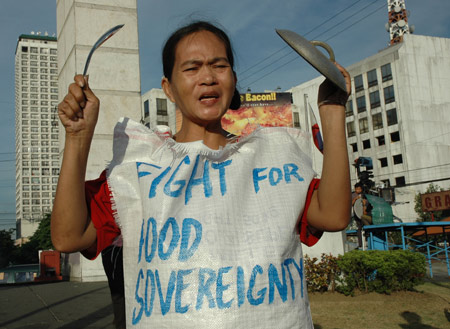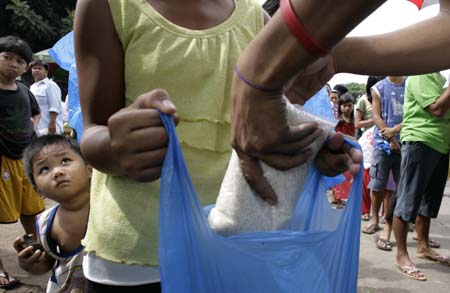A "silent tsunami" unleashed by costlier food threatens 100 million people, the United Nations said Tuesday, but views differed as to how to stop it.

A woman wears a rice sack during a protest on a street in Manila, the Philippines, April 16, 2008. The protestors are calling for stronger measures from the National Food Authority to increase the proportion of home-produced rice in its food reserve while punishing the regraters. The Philippines, one of the world's major consumers and importers of rice, is caught in the middle of a worsening global rice supply shortage.
The Asian Development Bank said there was enough food to go round, and the key was to help the poor afford it. It said Asian governments which have curbed food exports were over-reacting.
In London, Prime Minister Gordon Brown said Britain would seek changes to EU biofuels targets if it was shown that planting crops for fuel was driving up food prices - a day after the bloc stood by its plans to boost biofuel use.
Britain also pledged 900 million U.S. dollars to help the UN World Food Programme alleviate immediate problems and address longer-term solutions to "help put food on the table for nearly a billion people going hungry across the world."
The World Food Programme, whose head Josette Sheeran took part in a meeting of experts Brown called Tuesday to discuss the crisis, said a "silent tsunami" threatened to plunge over 100 million people on every continent into hunger.
"This is the new face of hunger - the millions of people who were not in the urgent hunger category six months ago but now are," Sheeran said ahead of the meeting.

A boy watches as a woman purchases government-subsidised rice from a mobile rice store operated from the back of a truck in Quezon City, Metro Manila April 15, 2008. Local prices have soared by up to 30 percent since the end of 2007 amid concerns about tight global supply, hoarding and rising demand from consumers spooked by the possibility of shortages.